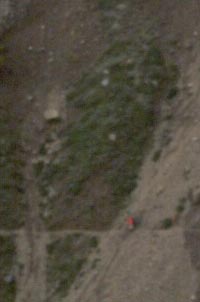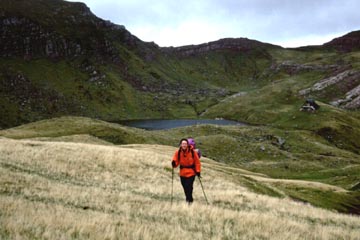In detail ...
I awoke dreamily with the name Candanchu on my lips and asked Karen 'Do you think it really is the city of a thousand dreams?' she laughed. It did seem to be a magical name, and as we had planned a rest day somewhere near Col du Somport, perhaps this place would fulfill all desire: mountain scenery, a hostel and well stocked shops. I poked my head out of the tent to survey the weather.
The wind and rain had abated, but it remained dull and misty, and there was little sign of life at this time; with one notable exception. A fleck of white on the purpling crags bounding Pic Rouge fixed my concentration, until it shifted and gave away its identity; a loan sheep which had escaped the flock to live 'free as an isard'. What a brave and unusual creature to forsake its peers and the protection offered by the
patou; and how fortunate that it had
not been chosen to carry a wretched bell which might have given it away at the point of escape, or could now betray the position of its little sheltered nook.
We packed briskly and were underway by 8:30am. The way lead along next to smaller peaks and purple pinnacled ridges which were home to alpine choughs and vultures. The nimble choughs were already active, while the vultures still decorated the rocks; no sign of a free lift yet for them. Nearer at hand the fat hoary marmots raced for cover, shrieking indignation. That always made for a laugh; if there be one creature which is not made for speed it would be the marmot, which is more ungainly towards its seasonal hibernation.
It seemed unlikely that the sun would appear that morning, so we were forced to a breakfast stop without it; the halt gave me an opportunity to collect mushrooms, which were prolific here-abouts. Few of them however were worth retaining, after invasion by maggots; small holes OK, big ones or the sight of a fat wriggler,
not OK, discard. I compromised a little, then later threw some of these out when even better supplies turned up by Lac d'Estaëns.
The first vultures were just getting airborne as we left, descending steeply to a sheep farm, where animal feet had warn countless permutations, obscuring the right way to go. Map and compass were mustered to confirm direction, traversing beneath some unlikely looking cliffs. Not so tricky as it appeared; steeper ground gave way to a
piste in the beechwoods which soon led us to Parking d'Espelunguére.
The track led out into open meadows studded with monster thistles; it was not the height, but the straw-golden flowers which justified the adjective. These short stemmed orbs were pressed flatly upon spreading rosettes of spiky ragged leaves. An altitude check (1380m) by the stream confirmed its identity but there was no sign of a
passarelle to enable easy crossing; stepping stones are always fun though. More deliberation followed as we hunted the right path up into the beechwoods. Our choice seemed to be leading in the right direction, and joining the steep course of a huge pipeline which we guessed came from the lake. By gentleman's agreement, the French draw water from Lac d'Estaëns which lies just inside the Spanish border.
The Great Black Woodpecker
French: 'Pic Noir'. Of the 6 woodpeckers endemic to the Pyrenees this is the largest, and unmistakeable if seen, being the size of a crow; it is all black except for a striking red poll. Being a shy bird it may be heard more often than seen. The song is a repeated doppler-shift cadence
ke-yaaaaw, while its warning call is a repeated ringing sound
brree-brree-brree- .... It demands extensive territory within the forest mountain stage.
The pipeline was generally well buried and we sometimes walked above it, but at one point it walled a little
grotte , where the happy coincidence of a dripping leak made an ideal home for a large toad. He shifted a bit as I peered in, but he had chosen well and was secure inside.
Karen_comments
Dark mauve-blue monks-hood flowers regaled the way and from afar came the haunting call of the Pic Noir as it searched the forests. The path became increasingly steep on a hillside to which the grass barely clung, affording great open views. The final 10m necessitated use of hands and then we popped out by the lake.
Voici!
The broken layered crags at the back of the lake largely comprised limestone making an impressive gnarly backdrop to the placid water, bounded by green meadows at the near end. Easy walking now, and it almost felt as though we had arrived, but the day held some surprises yet. Around the next hill-shoulder, we entered an enchanted valley which sources the river Aspe; it began with great mossy boulders in the beechwoods, then wayside crags, and finally a view to the head where a huge chicane of limestone was left as an outset remnant from erosion of the purple shale. Other beetling crags stood around and below them all, our route led across terminally steep shifting screes.

The position was so awsome that I immediately volunteered Karen to go ahead so that I could capture it on film. I did feel a twinge of guilt at sending her alone onto tricky terrain, but figured that she should be ready for anything by now. She disappeared into the woods ahead, and I had some minutes to count before she emerged onto the landslip area. There, her pace slowed,
OK, and she proceeded, then more slowly, and
stopped. It was some distance away and I could barely make her out as a fleck of red against the purple screes;
Voici!
what was going on? For a few moments she attempted to move, even back out, but then
froze completely.
Merde! I yelled some encouragement, hastily packing the camera; my guilt had already set out and was hauling me along by the throat,
you bloody fool ...!
When I broke from the trees, I was relieved to see her still there; she had frozen, appropriately enough at the very crux. The 'path' was a mere boot width until this point where it had slipped away for a couple of metres. With nothing to hand assist, it was necessary to edge the boots well and remain upright; but this act stretched credibility and I couldn't blame her for stopping. Frozen she had, but remained calm, no whimpering and she didn't even berate me! I passed her gingerly in an act which must have looked like a mating ritual, then trod the shale rigidly to turn and coax Karen across to easier ground;
phew!
Karen_comments
The rest of the way out remained interesting, but nothing challenged us again. I kept turning to view that cirque of crumbling twisted rocks,
Voici!
till it was blocked by nearer crags. Then the way lead out over bouldery pastures to join a track, and the first buildings were in sight; could this be Candanchu? We approached, first inquisitively, then incredulously; great ugly concrete appartment blocks stood all around. The ski-tow workings were everywhere and the ground had been bulldozed into broad moraine
pistes. To our left, a military camp was established inside a tall barbed mesh fence.
We trudged on, past a bulldozer raising clouds of dust. 'At least', I said to Karen, 'this place must have good facilities'. However, the
gite d'étape was closed 'out of season'. A tourist shop was open, selling flags, soft toys, key fobs and such, but not a scrap of food. The woman serving told us there was no other shop open; we must go way down into the Spanish valley, 'where we could have it all' at Canfranc. The road led on for many minutes as we marched through this deserted urban sprawl, finally snuffing out the last of 101 harboured expectations. We must depart this ghost town.
Easier said than done; there was little point in walking with miles of tarmac to go, so we smartened ourselves (if that were possible!) and waved thumbs at the passing traffic;
look bright and
SMILE. Cars (many of them from the military camp) had little time for us, so we edged out towards the main highway which is one of the busiest arteries breaching the Pyrenees, via Col du Somport. At last, a kind Spaniard pulled up for us; he was on his way to visit his son in Zaragoza, a journey which he did regularly. In view of which, it was a minor worry that he did not know of Canfranc; perhaps it was our pronunciation. I slumped in the back of the camping-car while Karen entertained our host in her 'second native tongue'; an act which never fails to put a smile on my face for it transforms her from the known and accessible to the obscure and secret.
We arrived at the undoubtedly insignifcant but noisy Canfranc to discover the
albuergue Pepito Grillo, and many rather urban or industrial buildings strung out either side of the main road. Just beyond, a railway carrying aggregate by the truckload explained the presence of dust everywhere.
There were at least, several shops including a small
supermercado. The whole town was set deep in the narrow valley where access from sunlight was limited; not exactly what we had wished for. Having checked into the
albuergue we raided the
supermercado and settled down to the preparation of a vast pot of stew. Which is to say, all we could eat and a little more based around a jar of
garbanzos. The consumption of this fayre soon encouraged repose and we slumped into our bunks for a long night. We were doubly grateful to be under a good roof when the storm broke, with heavy rain that lasted well into the following day.


